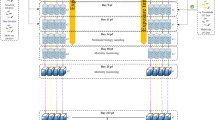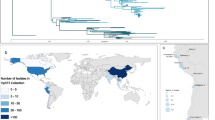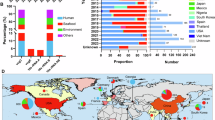Abstract
Vibrios are frequently associated with oyster mortality; however whether they are the primary causative agent or secondary opportunistic colonizers is not well understood. Here we combine analysis of natural infection dynamics, population genomics and molecular genetics to ask (i) to what extent oysters are passively colonized by Vibrio population present in the surrounding water, (ii) how populations turn over during pathogenicity events and (iii) what genetic factors are responsible for pathogenicity. We identified several populations of Vibrio preferentially associated with oyster tissues. Among these, Vibrio crassostreae is particularly abundant in diseased animals while nearly absent in the surrounding water, and its pathogenicity is correlated with the presence of a large mobilizable plasmid. We further demonstrate that the plasmid is essential for killing but not necessary for survival in tissues of oysters. Our results suggest that V. crassostreae first differentiated into a benign oyster colonizer that was secondarily turned into a pathogen by introgression of a virulence plasmid into the population, possibly facilitated by elevated host density in farming areas.
Similar content being viewed by others
Log in or create a free account to read this content
Gain free access to this article, as well as selected content from this journal and more on nature.com
or
References
Bachere E, Rosa RD, Schmitt P, Poirier AC, Merou N, Charriere GM et al. (2015). The new insights into the oyster antimicrobial defense: cellular, molecular and genetic view. Fish Shellfish Immunol 46: 50–64.
Ben Cheikh Y, Travers MA, Morga B, Godfrin Y, Rioult D, Le Foll F . (2016). First evidence for a Vibrio strain pathogenic to Mytilus edulis altering hemocyte immune capacities. Dev Comp Immunol 57: 107–119.
Cognie B, Barille L, Masse G, Beninger P . (2003). Selection and processing of large suspended algae in the oyster Crassostrea gigas. Mar Ecol Prog Ser 250: 145–152.
Demarre G, Guerout AM, Matsumoto-Mashimo C, Rowe-Magnus DA, Marliere P, Mazel D . (2005). A new family of mobilizable suicide plasmids based on broad host range R388 plasmid (IncW) and RP4 plasmid (IncPalpha) conjugative machineries and their cognate Escherichia coli host strains. Res Microbiol 156: 245–255.
Destoumieux-Garzon D, Rosa RD, Schmitt P, Barreto C, Vidal-Dupiol J, Mitta G et al. (2016). Antimicrobial peptides in marine invertebrate health and disease. Philos Trans R Soc Lond B Biol Sci e-pub ahead of print 26 May 2016; doi:10.1098/rstb.2015.0300.
Duperthuy M, Schmitt P, Garzon E, Caro A, Rosa RD, Le Roux F et al. (2011). Use of OmpU porins for attachment and invasion of Crassostrea gigas immune cells by the oyster pathogen Vibrio splendidus. Proc Natl Acad Sci USA 108: 2993–2998.
Faury N, Saulnier D, Thompson FL, Gay M, Swings J, Le Roux F . (2004). Vibrio crassostreae sp. nov., isolated from the haemolymph of oysters (Crassostrea gigas. Int J Syst Evol Microbiol 54: 2137–2140.
Froelich B, Ayrapetyan M, Oliver JD . (2012). Vibrio vulnificus integration into marine aggregates and subsequent uptake by the oyster, Crassostrea virginica. Appl Environ Microbiol 78: 3885–3889.
Hunt DE, David LA, Gevers D, Preheim SP, Alm EJ, Polz MF . (2008). Resource partitioning and sympatric differentiation among closely related bacterioplankton. Science 320: 1081–1085.
Ibarra JA, Steele-Mortimer O . (2009). Salmonella—the ultimate insider. Salmonella virulence factors that modulate intracellular survival. Cell Microbiol 11: 1579–1586.
Le Roux F, Binesse J, Saulnier D, Mazel D . (2007). Construction of a Vibrio splendidus mutant lacking the metalloprotease gene vsm by use of a novel counterselectable suicide vector. Appl Environ Microbiol 73: 777–784.
Le Roux F, Davis BM, Waldor MK . (2011). Conserved small RNAs govern replication and incompatibility of a diverse new plasmid family from marine bacteria. Nucleic Acids Res 39: 1004–1013.
Le Roux F, Wegner KM, Baker-Austin C, Vezzulli L, Osorio CR, Amaro C et al. (2015). The emergence of Vibrio pathogens in Europe: ecology, evolution, and pathogenesis (Paris, 11-12th March 2015). Front Microbiol 6: 830.
Le Roux F, Wegner KM, Polz MF . (2016). Oysters and Vibrios as a model for disease dynamics in wild animals. Trends Microbiol 24: 568–580.
Lemire A, Goudenege D, Versigny T, Petton B, Calteau A, Labreuche Y et al. (2015). Populations, not clones, are the unit of vibrio pathogenesis in naturally infected oysters. ISMEJ 9: 1523–1531.
Lokmer A, Kuenzel S, Baines JF, Wegner KM . (2016). The role of tissue-specific microbiota in initial establishment success of Pacific oysters. Environ Microbiol 18: 970–987.
Matsen FA, Kodner RB, Armbrust EV . (2010). pplacer: linear time maximum-likelihood and Bayesian phylogenetic placement of sequences onto a fixed reference tree. BMC Bioinformatics 11: 538.
Otto M . (2009) Bacterial sensing of antimicrobial peptides. In: Collin M, Schuch R (eds). Vol. 16. Contributions to Microbiology. KARGER: Basel, pp 136–149.
Pales Espinosa E, Koller A, Allam B . (2016). Proteomic characterization of mucosal secretions in the eastern oyster, Crassostrea virginica. J Proteomics 132: 63–76.
Petton B, Boudry P, Alunno-Bruscia M, Pernet F . (2015a). Factors influencing disease-induced mortality of Pacific oysters Crassostreae gigas. Aquac Environ Interact 6: 205–222.
Petton B, Bruto M, James A, Labreuche Y, Alunno-Bruscia M, Le Roux F . (2015b). Crassostrea gigas mortality in France: the usual suspect, a herpes virus, may not be the killer in this polymicrobial opportunistic disease. Front Microbiol 6: 686.
Petton B, Pernet F, Robert R, Boudry P . (2013). Temperature influence on pathogen transmission and subsequent mortalities in juvenile Pacific oysters Crassostrea gigas. Aquac Environ Interact 3: 257–273.
Preheim SP, Boucher Y, Wildschutte H, David LA, Veneziano D, Alm EJ et al. (2011). Metapopulation structure of Vibrionaceae among coastal marine invertebrates. Environ Microbiol 13: 265–275.
R Core Team (2016). R: A language and environment for statistical computing. R Foundation for Statistical Computing: Vienna, Austria. Available at https://www.R-project.org/.
Rui H, Ritchie JM, Bronson RT, Mekalanos JJ, Zhang Y, Waldor MK . (2010). Reactogenicity of live-attenuated Vibrio cholerae vaccines is dependent on flagellins. Proc Natl Acad Sci USA 107: 4359–4364.
Schmitt P, Rosa RD, Duperthuy M, de Lorgeril J, Bachere E, Destoumieux-Garzon D . (2012). The antimicrobial defense of the pacific oyster, Crassostrea gigas. how diversity may compensate for scarcity in the regulation of resident/pathogenic microflora. Front Microbiol 3: 160.
Szabo G, Preheim SP, Kauffman KM, David LA, Shapiro J, Alm EJ et al. (2012). Reproducibility of Vibrionaceae population structure in coastal bacterioplankton. ISME J 7: 509–519.
Tomich M, Planet PJ, Figurski DH . (2007). The tad locus: postcards from the widespread colonization island. Nat Rev Microbiol 5: 363–375.
Val ME, Skovgaard O, Ducos-Galand M, Bland MJ, Mazel D . (2012). Genome engineering in Vibrio cholerae: a feasible approach to address biological issues. PLoS Genet 8: e1002472.
Vallenet D, Belda E, Calteau A, Cruveiller S, Engelen S, Lajus A et al. (2013). MicroScope—an integrated microbial resource for the curation and comparative analysis of genomic and metabolic data. Nucleic Acids Res 41: D636–D647.
Vanhove AS, Rubio TP, Nguyen AN, Lemire A, Roche D, Nicod J et al. (2015). Copper homeostasis at the host vibrio interface: lessons from intracellular vibrio transcriptomics. Environ Microbiol 18: 875–888.
Watermann BT, Herlyn M, Daehne B, Bergmann S, Meemken M, Kolodzey H . (2008). Pathology and mass mortality of Pacific oysters, Crassostrea gigas (Thunberg), in 2005 at the East Frisian coast, Germany. J Fish Dis 31: 621–630.
Wendling CC, Batista FM, Wegner KM . (2014). Persistence, seasonal dynamics and pathogenic potential of Vibrio communities from pacific oyster hemolymph. PLoS One 9: e94256.
Xue H, Cordero OX, Camas FM, Trimble W, Meyer F, Guglielmini J et al. (2015). Eco-evolutionary dynamics of episomes among ecologically cohesive bacterial populations. MBio 6: e00552–00515.
Acknowledgements
We thank the staff of the station Ifremer Argenton and Bouin, the ABIMS and CRBM (Roscoff) and LABGeM (Evry) plateforms for technical support. The present study has been supported by the ANR (13-ADAP-0007-01«OPOPOP», MB fundings), Ifremer (MB and AJ fundings) and Region Bretagne (AJ funding).
Author contributions
AJ, BP, YL, SC, MAB and FLR performed experiments. MB performed the in silico analyses, MB and AJ the statistics. MB, FLR and MP designed experiments, interpreted results and wrote the paper. MB and AJ contribute equally to this work. The manuscript has been seen and approved by all of the authors.
Author information
Authors and Affiliations
Corresponding authors
Ethics declarations
Competing interests
The authors declare no conflict of interest.
Additional information
Supplementary Information accompanies this paper on The ISME Journal website
Supplementary information
Rights and permissions
About this article
Cite this article
Bruto, M., James, A., Petton, B. et al. Vibrio crassostreae, a benign oyster colonizer turned into a pathogen after plasmid acquisition. ISME J 11, 1043–1052 (2017). https://doi.org/10.1038/ismej.2016.162
Received:
Revised:
Accepted:
Published:
Issue date:
DOI: https://doi.org/10.1038/ismej.2016.162
This article is cited by
-
Comparative genomics of Vibrio toranzoniae strains
International Microbiology (2024)
-
Beneficial microorganisms for the health-promoting in oyster aquaculture: realistic alternatives
Aquaculture International (2024)
-
A core of functional complementary bacteria infects oysters in Pacific Oyster Mortality Syndrome
Animal Microbiome (2023)
-
The RIX domain defines a class of polymorphic T6SS effectors and secreted adaptors
Nature Communications (2023)
-
Phage–host coevolution in natural populations
Nature Microbiology (2022)



